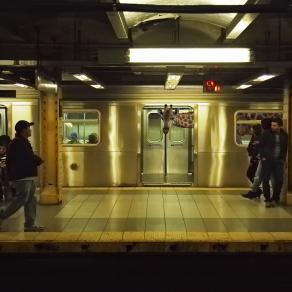George Grubb
Artist, New York City, United States, joined 10 years ago
In absurdity, there is clarity. Thus, the premise for this ongoing project is to use a unique approach to raise awareness of a well published problem; the need for greater conservation efforts to protect our endangered wildlife by juxtaposing them in an environment that is absurd…Manhattan. This collection of digital compositions features an assimilation of the Artist’s wildlife and urban street photography. The images have been captured, over the years, in his travels and in his hometown, New York City. The animals depicted herein are all wild, and were photographed during those journeys to visit their natural environments in threatened regions around the World, such as the ice pack of the Arctic, the Island of South Georgia off Antarctica, and the jungles in Rwanda and Uganda. These animals and their habitats are threatened by man, either through climate change, poaching, urban development or other intrusions into their environments. This project seeks to raise awareness of the plight of these animals by raising the simple question, “if we cannot protect our wildlife in their own natural habitats, where can they be safe?”
The elements of absurdity are used to entice the viewer into the photograph, to arouse curiosity and to seek to learn more about the image. Absurdity is further extended into the titling of the images to convey playfulness on the surface, as well as to metaphorically portray our ignorance of their struggles for survival. Many of the images depict New Yorkers so engrossed in their thoughts and gadgets that they fail to even recognize the presence of these animals in their environment. Some of the images depict the locals stopping to take notice, as if they are pondering their reasons for their presence, suggesting the viewer, too, ponder this as well.
In the print series, a story is told of the obstacles to survival of that species, and the current threat ratings from the International Union for the Conservation of Nature’s (IUCN) Red List. For example, few people realize that there are nine subspecies of the giraffe family, with one species, the Rothschild Giraffe, being so endangered that only a few hundred are believed to be living in the wild today. The mountain gorilla (less than 1,000) and the black rhino (less than 5,000) are also critically endangered with numbers considered absurdly low. The artist introduces us to species not on the popular radar, such as the Red-crowned cranes, which only around 2,750 are believed to survive in the wild. Some species, like the warthogs, are believed to have stable populations, but scientists are reporting their extirpation from some of their natural habitats, likely due to the hunting for their ivory tusks. Even the hippopotamus, perceived to be in abundance, has recently seen horrific slaughters and is now listed as “Vulnerable.” In the Congo, 95% of their population has been wiped out in the last few years, as they are poached for their ivory teeth and bush meat. The elephant slaughters are rising, with 650 being slaughtered in a few days in Bouba N’Djida park in 2012, and 86 (including 33 pregnant females) being slaughtered in Chad in less than a week in 2013. Even two of the three species of Zebras are now struggling, with the Grevy’s Zebra now listed as “Endangered” and the Mountain Zebra listed as “Vulnerable.” Most viewers today recognize the topic of wildlife conservation, but few recognize the gravity of it. The Artist hopes to help increase awareness of the urgency of this crisis through his work.
News
celeste,












